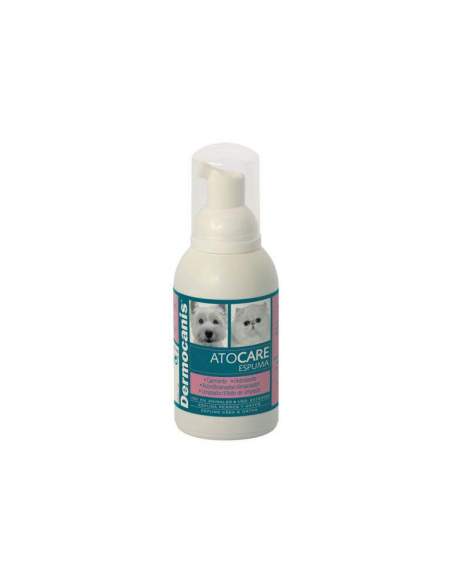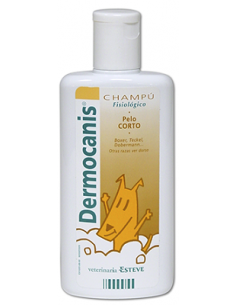The use of Dermocanis Alercure (now Dermocanis Atocare) is especially indicated for the hygiene and cleaning of the skin of dogs and cats to maintain the physiological conditions, even of animals with dermal problems of eczematous type treated clinically.
Its composition, based on proteins and polyunsaturated fatty acids essential for the epidermis, makes it especially effective against eczematous and inflammatory processes of the dog's skin. Its excellent tolerance makes it very suitable for habitual use in dogs with delicate, dry or scaly skin.
Essential fatty acids of the polyunsaturated type are fundamental components of cell membranes regulating their permeability and flexibility and acting at the same time as precursors of prostaglandins. These fatty acids cannot be synthesized by the dog, so they must be provided either orally or topically. In dogs with inflammatory dermatitis, the metabolism of essential fatty acids, from the diet, is altered so that the formation of prostaglandins type 1 (PGE1), of anti-inflammatory activity is diminished, while the formation of prostaglandins type 2 ( PGE2), of pro-inflammatory activity, is at normal levels. As a result, there is an imbalance between the two types of prostaglandins, with a higher proportion of PGE2, which causes inflammation of the skin, formation of edema, itching, etc. Dermocanis Alercure shampoo supplies, directly to the dog's skin, gamma linolenic acid (GLA; C18: 3 n-6), which modulates the synthesis of PGE 1 that is reduced, regulating the proportions between PGE 1 and PGE 2. As a result, the inflammation of the skin and the physiological disorders that accompany it decrease, improving the condition of the stratum corneum. The contribution of GLA, therefore, plays a beneficial role in the treatment of inflammatory skin disorders, especially in dry and scaly skin, eczema and hyperkeratosis.
The cleansing, moisturizing and conditioning power of Dermocanis ALERCURE, removes dirt and allergens from the surface of the skin, regulates its flexibility and permeability, returning its natural properties and reducing the intensity of pruritus. The improvement of the state of the skin increases the welfare of the animal and in cases where it is necessary, allows the optimal effectiveness of other more radical treatments.
How to use
- Wet the animal's hair with warm water.
- Shake the container and apply the shampoo at different points and in sufficient quantity depending on the thickness of the hair and size of the animal.
- Spread throughout the body by rubbing with the fingers to facilitate the penetration of the shampoo.
- Leave on for 3-5 minutes.
- Rinse with plenty of water until all foam is removed.
The frequency of washing will depend on the intensity of the symptoms and the veterinarian's indications. In general it is advisable to start with frequent baths, two or three times a week and reduce the frequency as the process is controlled. In dogs with dry or delicate skin it is advisable to continue using this product as a shampoo for regular use.
Warnings
In case of contact with eyes, clean immediately with warm water. The dog's skin allergies can be caused by autoimmune processes or by a multitude of external allergens (food, pollen, fleas, bacteria, etc.) whose simultaneous control is indispensable for the complete resolution of the process.
CANINE ALLERGIES
Canine allergy is an inherited predisposition of some dogs' immune system to overreact to normally harmless substances. These substances, called allergens, are usually found in the environment and all animals are exposed to them.
Although hereditary factors are very important in the development of the disease, the appearance of clinical symptoms requires exposure to a minimum amount of different allergens in each individual and that varies depending on factors such as the presence of other diseases, irritating substances, environment, alterations. of the skin, etc. When the different allergens (food, fleas, pollen, bacteria, etc.), exceed the minimum threshold, the clinical allergy appears. The most common allergic reactions are those of type I, including atopy, food allergy or flea bite allergic dermatitis (DAPP). They produce IgE antibodies against external allergens that penetrate the body.
When in a second contact the antigen binds to IgE triggers the release of humoral substances: histamine, heparin, prostaglandins, etc. These mediators cause pruritus, vasodilation, edema and inflammation of the skin. The constant scratching and licking by the dog, subsequently causes alopecia and scoria that predispose to skin infections.
In the case of autoimmune dermatoses, the animal is immunized against constituents of its own organism. In vesicular type, Pemphigus, the body makes antibodies that directly attack the cell membranes of its own epidermis (type II reaction). Non-vesicular, Lupus, are cutaneous manifestations of other diseases that occur with the appearance of antigen-antibody complexes. These, in turn, are deposited in the tissues and produce pathological alterations (type III reaction). Finally, contact allergies produce hypersensitivity reactions of a cellular or delayed type (type IV). They are normally located in the trunk, abdomen and extremities.
Presentation: 250 ml shampoo bottle
Manufacturer: ECUPHAR











